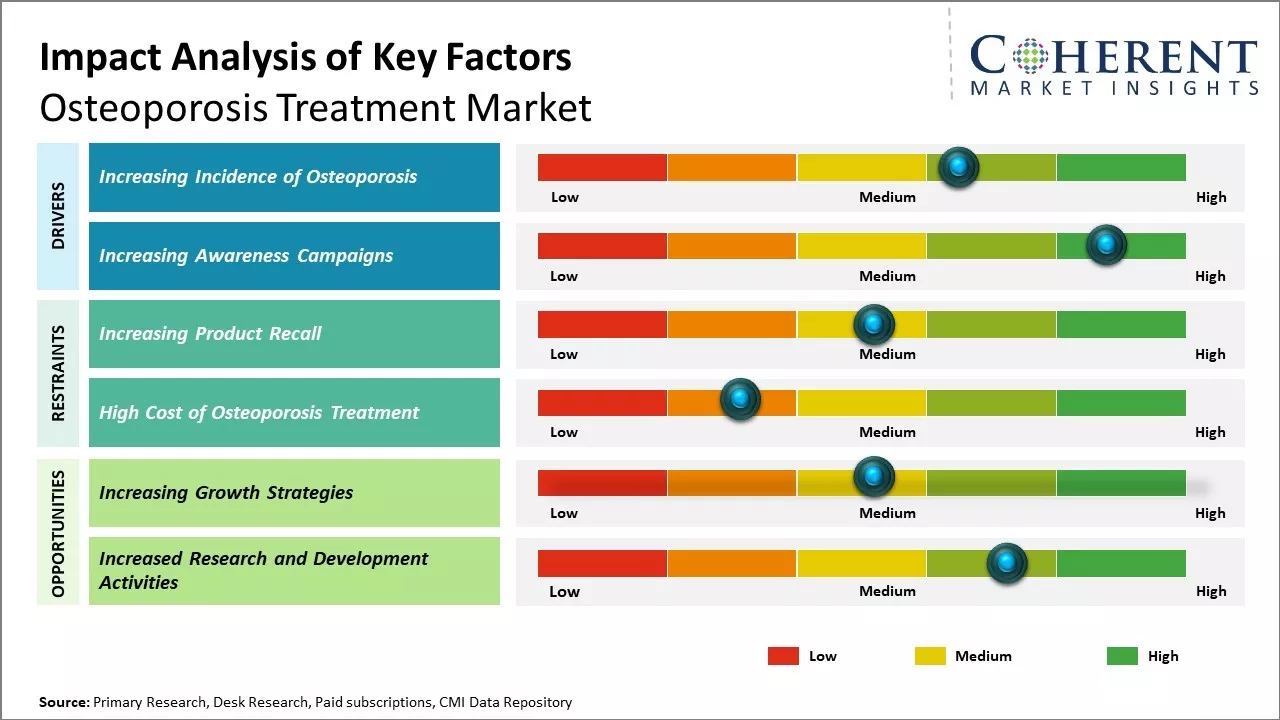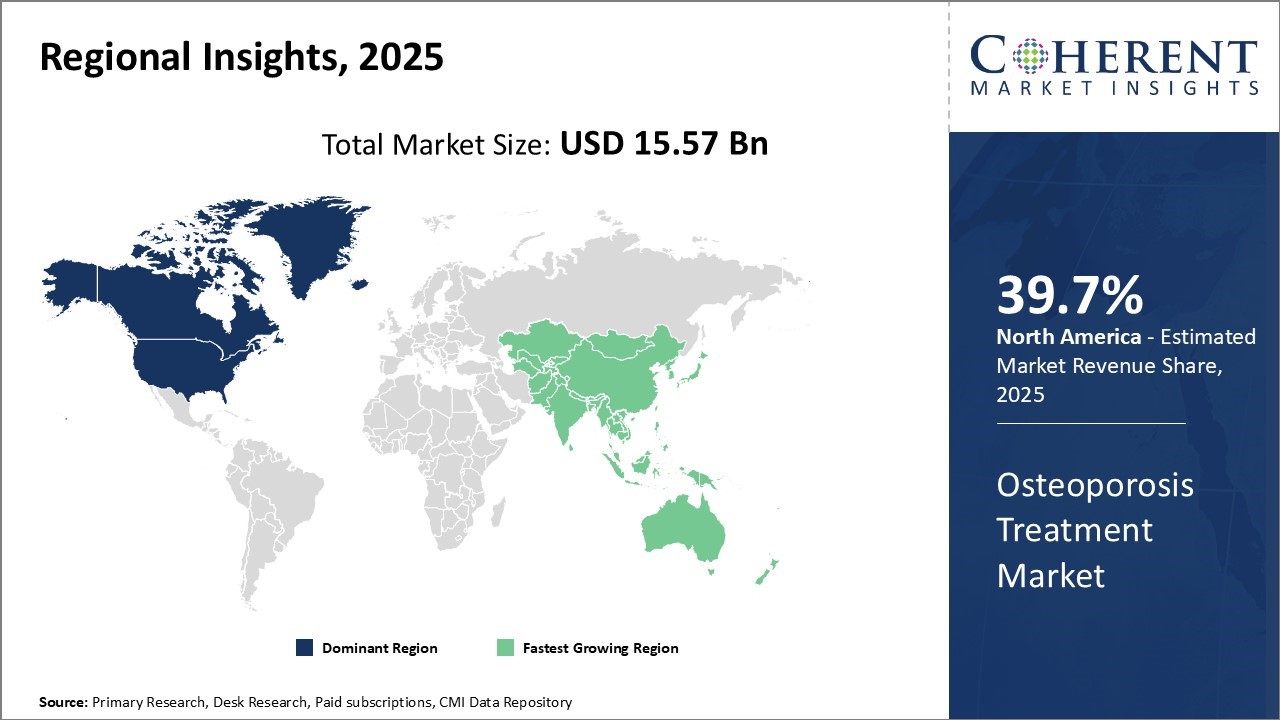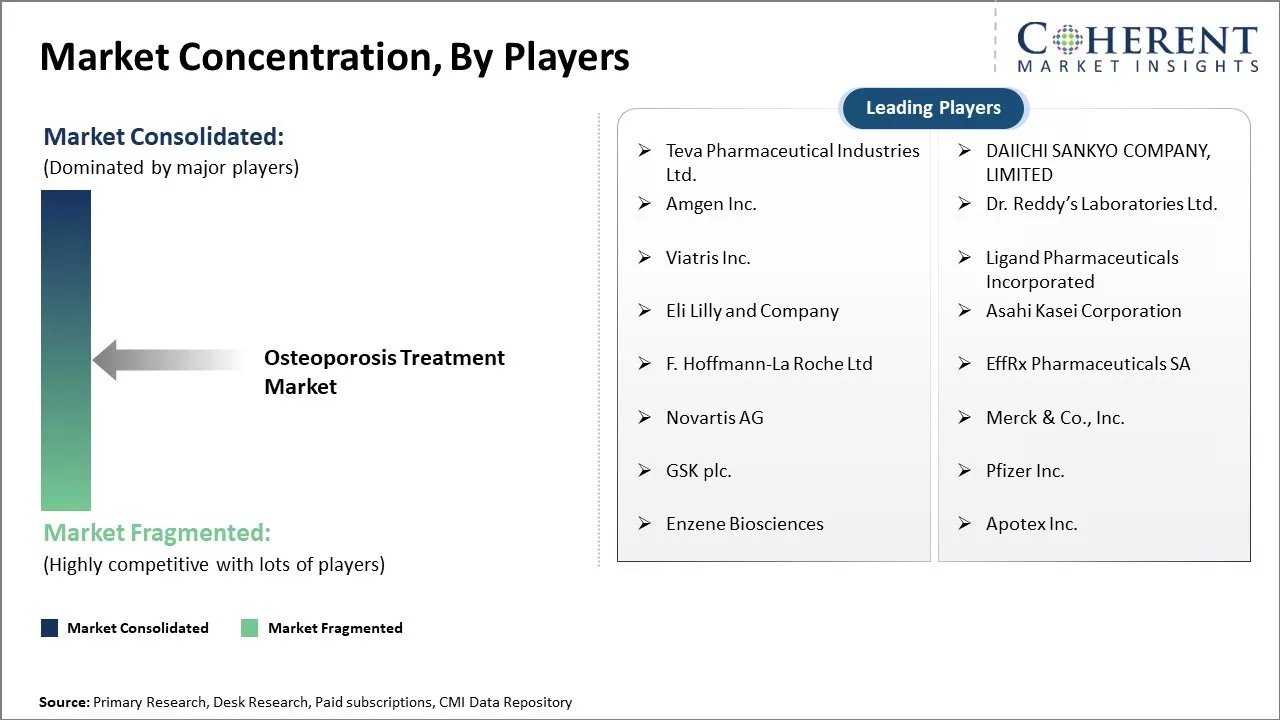Global osteoporosis treatment market is estimated to be valued at USD 15.57 Bn in 2025 and is expected to reach USD 21.06 Bn by 2032, exhibiting a compound annual growth rate (CAGR) of 4.4% from 2025 to 2032.

To learn more about this report, Download Free Sample
The global osteoporosis treatment market is witnessing a rising demand as it helps reduce the risk of broken bones (also referred to as fractures) due to osteoporosis. The treatment generally includes prescribed medication along with intake of an adequate amount of calcium, vitamin D, and regular exercise. The osteoporosis treatment is often based on an estimation of the risk of breaking a bone in the next 10 years, which is determined through a bone density test. Some common medications include Bisphosphonates, Denosumab, hormone-related therapy, and bone-building medications (teriparatide, abaloparatide, romosozumab).
Additionally, the introduction of novel therapeutics and self-administerable formulations is expected to boost the osteoporosis market growth.
|
Current Events |
Description and its Impact |
|
Market-Specific Demand Drivers |
|
|
Socioeconomic and Healthcare Infrastructure Factors |
|
Uncover macros and micros vetted on 75+ parameters: Get instant access to report
Reimbursement policies for osteoporosis treatment vary by country but play a pivotal role in improving access to therapies and early diagnostic procedures. In many developed nations such as Germany, France, Japan, and Australia, national health insurance schemes typically cover the costs of essential diagnostic tests like Dual-energy X-ray Absorptiometry (DEXA) scans and first-line treatments including bisphosphonates, hormone replacement therapy, and biologics. For example, in Germany, public insurance providers reimburse both DEXA scans and long-term use of bone density drugs for postmenopausal women and high-risk patients, encouraging early diagnosis and adherence to treatment. In Japan, the universal health coverage model allows for widespread reimbursement of combination osteoporosis therapies, which improves treatment compliance in elderly populations. In contrast, developing countries like India are gradually expanding reimbursement under public health programs, but coverage often remains limited to generic drugs, with advanced biologics requiring out-of-pocket expenses.
In terms of drug type, the bisphosphonates segment is estimated to hold 32.6% of the market share in 2025 owing to its potent bone building properties. Bisphosphonates are synthetic analogs of pyrophosphate that bind strongly to the mineralized hydroxyapatite surface of bones. Once bound, bisphosphonates are slowly released from the bone surface and continue to inhibit osteoclast activity and reduce bone resorption. Due to their unique mechanism of action, bisphosphonates are able to significantly reduce fractures in patients with osteoporosis by inhibiting bone resorption and maintaining bone mineral density. Among the bisphosphonate class of drugs, alendronate and risedronate are commonly prescribed oral formulations that are highly effective in building bone mass. The strong clinical profile of bisphosphonates drives their use as the first line therapy, contributing to their leading market share.
In January 2023, the American College of Physicians (ACP) has updated its guideline on managing primary osteoporosis, now strongly advising bisphosphonates such as alendronate, ibandronate, risedronate, and zoledronate, as the initial pharmacologic treatment for postmenopausal women and men to prevent fractures.
In terms of route of administration, the oral segment is estimated to hold 53.1% of the market share in 2025 owing to its flexible dosing options. The oral route is the most preferred method of delivery in osteoporosis treatment as it offers convenience of self-administration and flexible dosing schedules. Oral bisphosphonates like alendronate and risedronate which dominate the drug market, can be taken once-weekly or monthly. This flexible dosing regimen of oral bisphosphonates increases patient compliance compared to injections. The oral route highly suitable for long-term treatment of osteoporosis, thereby, accounting for its large share in route of administration segment.
In May 2025, Eton Pharmaceuticals, a leader in rare‑disease therapeutics, announced FDA approval of KHINDIVI™ (hydrocortisone) Oral Solution. This marks the first and only FDA‑approved liquid hydrocortisone for pediatric patients aged five and older with adrenocortical insufficiency. The ready-to-use 1 mg/mL formulation eliminates the need for crushing tablets and supports precise dosing without refrigeration, mixing, or shaking, further accelerating the osteoporosis market growth.
In terms of distribution channel, the hospital pharmacies segment is estimated to hold 41.9% of the market share in 2025 owing to available expertise and monitoring facilities. When initiating osteoporosis treatment, medical practitioners prefer recommending drugs through hospital pharmacies. Retail pharmacies and online pharmacies are feasible options for refilling prescriptions. Hospital pharmacies also carry the wider range of drugs and therapies to tackle challenging cases. Given the requirement of specialized care for osteoporosis management, patients rely on hospital pharmacies at the onset of treatment. This drives their large share in the distribution channel segment.

To learn more about this report, Download Free Sample
North America remains the dominant region in the global osteoporosis treatment market and is estimated to hold 39.7% of the market share in 2025. The U.S. accounts for the bulk of the market in North America due to favorable reimbursement policies and higher healthcare spending. Several leading global pharmaceutical companies are headquartered in the U.S. and have been actively investing in developing innovative drugs for bone health. This strong industry presence combined with aggressive marketing campaigns has kept awareness and diagnosis rates high in the region. Furthermore, the aging population and their higher disposable incomes make North America an attractive market.
In May 2025, Osteoboost Health launched its first FDA‑cleared, prescription wearable device designed to treat low bone density in postmenopausal women. Cleared via the De Novo pathway and designated a Breakthrough Device, the belt delivers targeted vibration therapy to the spine and hips—regions most vulnerable to fractures.
The Asia Pacific region has emerged as the fastest-growing market for osteoporosis treatment globally in recent years. Countries like China and Japan have aging societies, which boosts the prevalence of bone diseases. However, in many developing Asian countries, osteoporosis continues to be an under-diagnosed and under-treated condition. This large untreated patient base presents new opportunities for manufacturers. The presence of many global generics manufacturers in India and China is also pushing down treatment prices, making drugs more affordable. These lower costs, coupled with improving access to healthcare infrastructure and rising standards of living, mean more patients can now access treatment. Governments are also launching awareness programs to educate people on bone health as the economic and healthcare burden of osteoporosis rises.
In India, two major efforts launched in late 2024 are accelerating the osteoporosis market demand. Pharmed Limited introduced the India Bone Health Initiative on World Osteoporosis Day, offering public education, free Bone Mineral Density (BMD) outreach camps, and early screening programs nationwide. Around the same time, Star Health Insurance ran a countrywide osteoporosis awareness campaign across 46 Indian cities, providing free scans and wellness sessions, predominantly targeting women to promote early diagnosis and prevention
The United States is a key market for osteoporosis treatment, driven by a large aging population and high rates of postmenopausal osteoporosis. Widespread access to DXA scans, strong healthcare infrastructure, and insurance reimbursement support early diagnosis and treatment. Following the U.S. Surgeon General’s focus on bone health, nationwide efforts expanded access to screening and fracture prevention therapies. According to the National Osteoporosis Foundation, over 10 million Americans are estimated to have osteoporosis, and another 44 million have low bone density, placing them at increased risk. This demographic trend is driving consistent demand for advanced treatment solutions. As a result, use of medications like bisphosphonates and anabolic agents has grown. Public health campaigns and clinical programs continue to fuel strong demand in the osteoporosis treatment market.
Japan is a key driver in the osteoporosis treatment market due to its aging population and strong public health initiatives. The government promotes bone density screening for women over 40 and has approved advanced drugs like romosozumab to manage postmenopausal osteoporosis. With broad insurance coverage and fast regulatory approvals, Japan significantly supports the osteoporosis treatment market through improved access and rising treatment adoption.
Germany is a key driver in the osteoporosis treatment market due to strong public awareness, early screening programs, and broad access to biosimilar and combination therapies. Reimbursement for DEXA scans by German health insurers has improved early diagnosis rates, especially among older women. The country also promotes the use of advanced biologics like denosumab, supported by national guidelines and insurance coverage, boosting both adherence and demand.

To learn more about this report, Download Free Sample
| Report Coverage | Details | ||
|---|---|---|---|
| Base Year: | 2024 | Market Size in 2025: | USD 15.57 Bn |
| Historical Data for: | 2020 To 2024 | Forecast Period: | 2025 To 2032 |
| Forecast Period 2025 to 2032 CAGR: | 4.4% | 2032 Value Projection: | USD 21.06 Bn |
| Geographies covered: |
|
||
| Segments covered: |
|
||
| Companies covered: |
Teva Pharmaceutical Industries Ltd., DAIICHI SANKYO COMPANY, LIMITED, Amgen Inc., Dr. Reddy’s Laboratories Ltd., Viatris Inc., Ligand Pharmaceuticals Incorporated, Eli Lilly and Company, Asahi Kasei Corporation, F. Hoffmann-La Roche Ltd, EffRx Pharmaceuticals SA, Novartis AG, Merck & Co., Inc., GSK plc., Pfizer Inc., Enzene Biosciences, Apotex Inc. |
||
| Growth Drivers: |
|
||
| Restraints & Challenges: |
|
||
Uncover macros and micros vetted on 75+ parameters: Get instant access to report
The rising prevalence and incidence of osteoporosis are significantly contributing to the expansion of the osteoporosis treatment market share globally. Osteoporosis, often called the "silent disease," weakens bones and increases the risk of sudden fractures, particularly among the aging population. As per the International Osteoporosis Foundation, over 8.9 million fractures are attributed to osteoporosis annually—equating to one fracture every 3 seconds. This alarming statistic underscores the urgent need for effective treatment and prevention solutions.
The growing burden of osteoporosis is compelling healthcare systems and pharmaceutical companies to invest in advanced therapies such as bisphosphonates, monoclonal antibodies (e.g., denosumab), and newer anabolic treatments. Moreover, early screening programs, government awareness campaigns, and the increasing availability of bone mineral density testing are further fueling the demand for osteoporosis therapies. Collectively, these factors are boosting the osteoporosis treatment market revenue, particularly in regions with rapidly aging demographics such as Europe, Japan, and the U.S.
Increasing awareness campaigns are playing a significant role in driving osteoporosis treatment market growth globally. Government bodies, healthcare organizations, and NGOs are actively conducting educational programs to improve public knowledge about the risks and symptoms of osteoporosis, especially among postmenopausal women and the elderly. These initiatives aim to promote early diagnosis, lifestyle changes, and adherence to treatment regimens. For instance, World Osteoporosis Day, observed annually on October 20, sees global campaigns that highlight the importance of bone health and preventive care. Such efforts are encouraging more people to seek timely medical advice and treatment, thereby fueling the demand for osteoporosis therapies.
In August 2024, the International Osteoporosis Foundation (IOF) launched its “Say no to fragile bones” campaign. With up to 37 million fragility fractures globally each year, IOF urges individuals of all ages to prioritize bone health through nutrition, weight‑bearing exercise, and avoidance of risk factors like smoking. The campaign encourages risk screening, treatment adherence, and elevating bone health in public policy, especially funding post‑fracture care for those over 50. Organizations are invited to host awareness events and register them on the WOD Global Events map to maximize impact.
Increasing growth strategies such as strategic partnerships, product launches, and geographic expansion are playing a pivotal role in shaping the osteoporosis treatment market forecast. Leading pharmaceutical and biotech companies are actively collaborating with research institutes and healthcare providers to develop novel therapies and improve treatment accessibility. For example, firms are entering into licensing agreements to co-develop biologics and monoclonal antibodies targeting osteoporosis pathways, particularly for patients with severe or treatment-resistant forms of the disease. Additionally, the market is witnessing a surge in new product approvals that offer enhanced efficacy or fewer side effects, which is likely to boost physician adoption. Companies are also expanding into untapped markets, especially in Asia and Latin America, where aging populations are increasing demand for osteoporosis care. These aggressive strategies are expected to significantly elevate the osteoporosis treatment market opportunity over the forecast period.
For instance, in February 2023, the World Health Organization (WHO) and the European Society for Clinical and Economic Aspects of Osteoporosis, Osteoarthritis and Musculoskeletal Diseases (ESCEO) signed an agreement to develop a strategic roadmap on bone health and ageing and advocate for a public health strategy to prevent fractures among older people.
*Definition: Osteoporosis is characterized by reduction in the density and quality of bones that often result in broken bones in the wrist, hip, and spine. Various factors responsible for osteoporosis include, genetic factors, low intake of calcium, magnesium, and vitamin D, eating disorders such as anorexia, inactivity and immobility, and excessive alcohol intake. Moreover, conditions that increase the risk of osteoporosis include, cancer, chronic kidney diseases, chronic obstructive pulmonary disease, and some autoimmune diseases such as rheumatoid arthritis.
Share
Share
About Author
Vipul Patil is a dynamic management consultant with 6 years of dedicated experience in the pharmaceutical industry. Known for his analytical acumen and strategic insight, Vipul has successfully partnered with pharmaceutical companies to enhance operational efficiency, cross broader expansion, and navigate the complexities of distribution in markets with high revenue potential.
Missing comfort of reading report in your local language? Find your preferred language :
Transform your Strategy with Exclusive Trending Reports :
Frequently Asked Questions
Joining thousands of companies around the world committed to making the Excellent Business Solutions.
View All Our Clients